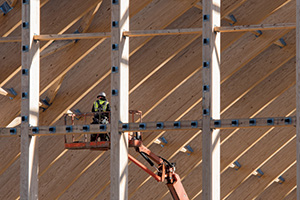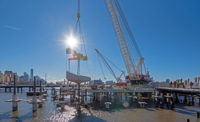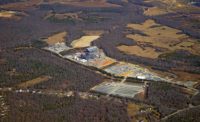The eclectic array of largest projects to break ground in the New York region in 2017—including Delta Airlines’ Terminals C and D at LaGuardia Airport, a Hard Rock hotel and casino in Atlantic City, N.J., the Atlantic Bridge natural gas pipeline in New Jersey and the Gowanus Canal Superfund site continued cleanup in Brooklyn—offer more evidence of a cooling high-rise residential construction market that carried over from 2016.
The largest 30 projects on this year’s Top Starts list, which was compiled from Dodge Data & Analytics information, totaled $15.89 billion, out of the region’s total $113.6 billion in starts. The $4-billion LaGuardia Airport terminals renovation was the largest project, slightly exceeding the $3.98-billion Central Terminal replacement that topped last year’s list.
 |
| The Kartrite resort, slated to finish construction in the Catskills in December, will include a 98,000-sq-ft indoor water park and a sevenstory, 324-room hotel. PHOTO BY PAUL KNAPICK |
While residential work found its way onto our list, there were also commercial and hospitality projects as well as energy construction, both traditional and renewable. Public works and infrastructure are getting major attention—including an array of projects begun by the New Jersey Dept. of Transportation, fueling its selection as this year’s Owner of the Year (see story here). NJDOT began projects, including two on our list, worth $614.7 million. Infrastructure professionals tell ENR they think the state’s newly named transportation commissioner, Diane Gutierrez-Scaccetti, will push forward on much needed work, propelled by additional funding from the 2016 passage of a 23-cent-per-gallon hike in the state gas tax.
New York also is prioritizing infrastructure. The $1.6-billion, 255,000-sq-ft Moynihan Train Hall and Farley Post Office renovation project in Manhattan began in June. And the Jacob K. Javits Convention Center began a $1.2-billion expansion whose challenges include digging a foundation atop the Lincoln Tunnel (see story here).
A report released March 6 by the New York Building Congress found capital spending for fiscal 2019 will increase to $11.8 billion from $9 billion in 2018, and will rise another $1.7 billion in 2020. With extensive criticism about the condition of city subways, “the prolonged stability and growth of the city is contingent on ... safe and reliable transportation, and a basic state of good repair of the city’s infrastructure,” Carlo A. Scissura, Building Congress CEO, said in a release (see news brief here).
Projects just starting in residential and hospitality spaces are taking advantage of new links to existing neighbors, generated by changed air rights rules. The 1 Clinton St. project in Brooklyn, a $280-million effort to replace a library branch with one spanning 26,620 sq ft and three stories, will include 134 condo units on 36 floors built above the library. The 9 DeKalb Ave. condo tower in Brooklyn will top out at 73 stories, high above its neighbors. Marci Clark, director at JDS Development Group, the $325-million project’s general contractor, says a major challenge was “stitching together” the new structure with the landmark Dime Savings Bank of Brooklyn.
 |
| The planned hotel at 255 W. 34th St. looks a bit like a chocolate bar dipped in a jar of peanut butter— and its use and construction are just as disparate. The first eight floors will be framed in steel, partly to offer retail tenants column-free space, while much of the hotel will be made of flat plate concrete. RENDERING COURTESY STONEHHILL & TAYLOR |
Other projects are set to woo visitors, not residents. The Kartrite will become an alternative to resorts down south. The $160-million project in the Catskills town of Monticello, N.Y., includes a 98,000-sq-ft indoor water park and a seven-story, 324-room hotel.
In Manhattan, the 32-story planned hotel at 255 W. 34th St. will function as two buildings in one—in both use and construction method. The first eight floors will be framed in steel, in part to accommodate retail tenants who prize column-free spaces, with the remaining 24 stories made of flat plate concrete, says Neill Parker, project manager at Stonehill & Taylor Architects. Builders also are using a secant-pile wall system to drill concrete deeper than existing footings of neighbors immediately to the east and north, “almost like beams running up and down, like a Daniel Boone fort,” he says.
There are also projects that will aid the environment. The Hub at Harrison in Harrison, N.J., will transform a former brownfield into a mixed-use complex that includes four five-story wood-framed buildings. In upstate New York, the Arkwright Summit and Copenhagen wind farms, costing a combined $292.8 million, also broke ground. Clean energy (see news brief here) will certainly help propel the construction industry into the future.





